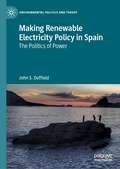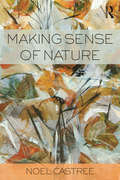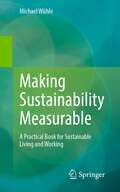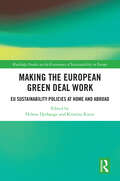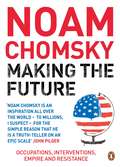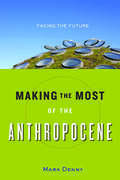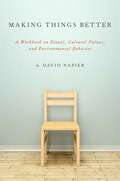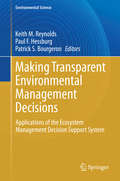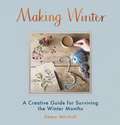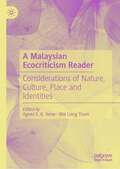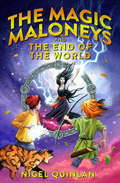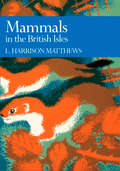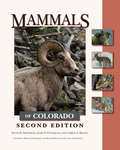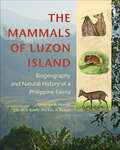- Table View
- List View
Making Renewable Electricity Policy in Spain: The Politics of Power (Environmental Politics and Theory)
by John S. DuffieldThis book examines the politics of renewable electricity policy in democratic Spain. It provides the first comprehensive political analysis of how and why successive Spanish governments have increased or reduced support for renewable power, especially wind and solar. In particular, it identifies the key influences that have been brought to bear on decision making by the core executive as it has sought to determine the appropriate role of renewable sources in the country’s electricity mix. Following the introduction, four chapters chart the dramatic rise, fall, and, most recently, renewed rise in support for utility-scale renewable power, from the early 1980s to the present. Another chapter details the decade-long political struggle over the regulation of small-scale distributed renewable electricity generation. The penultimate chapter explores the future prospects for renewable power in Spain, and the final chapter offers an overarching explanation of the patterns of policy outcomes observed.
Making Sense of Nature
by Noel CastreeWe listen to a cacophony of voices instructing us how to think and feel about nature, including our own bodies. The news media, wildlife documentaries, science magazines, and environmental NGOs are among those clamouring for our attention. But are we empowered by all this knowledge or is our dependence on various communities allowing our thoughts, sentiments and activities to be unduly governed by others? Making Sense of Nature shows that what we call ‘nature’ is made sense of for us in ways that make it central to social order, social change and social dissent. By utilising insights and extended examples from anthropology, cultural studies, human geography, philosophy, politics, sociology, science studies, this interdisciplinary text asks whether we can better make sense of nature for ourselves, and thus participate more meaningfully in momentous decisions about the future of life – human and non-human – on the planet. This book shows how ‘nature’ can be made sense of without presuming its naturalness. The challenge is not so much to rid ourselves of the idea of nature and its ‘collateral concepts’ (such as genes) but instead, we need to be more alert to how, why and with what effects ideas about ‘nature’ get fashioned and deployed in specific situations. Among other things, the book deals with science and scientists, the mass media and journalists, ecotourism, literature and cinema, environmentalists, advertising and big business. This innovative text contains numerous case studies and examples from daily life to put theory and subject matter into context, as well as study tasks, a glossary and suggested further reading. The case studies cover a range of topics, range from forestry in Canada and Guinea, to bestiality in Washington State, to how human genetics is reported in Western newspapers, to participatory science experiments in the UK. Making Sense of Nature will empower readers from a wide range of fields across the social sciences, humanities and physical sciences.
Making Sense of Nature
by Noel CastreeWe listen to a cacophony of voices instructing us how to think and feel about nature, including our own bodies. The news media, wildlife documentaries, science magazines, and environmental NGOs are among those clamouring for our attention. But are we empowered by all this knowledge or is our dependence on various communities allowing our thoughts, sentiments and activities to be unduly governed by others? Making Sense of Nature shows that what we call ‘nature’ is made sense of for us in ways that make it central to social order, social change and social dissent. By utilising insights and extended examples from anthropology, cultural studies, human geography, philosophy, politics, sociology, science studies, this interdisciplinary text asks whether we can better make sense of nature for ourselves, and thus participate more meaningfully in momentous decisions about the future of life – human and non-human – on the planet. This book shows how ‘nature’ can be made sense of without presuming its naturalness. The challenge is not so much to rid ourselves of the idea of nature and its ‘collateral concepts’ (such as genes) but instead, we need to be more alert to how, why and with what effects ideas about ‘nature’ get fashioned and deployed in specific situations. Among other things, the book deals with science and scientists, the mass media and journalists, ecotourism, literature and cinema, environmentalists, advertising and big business. This innovative text contains numerous case studies and examples from daily life to put theory and subject matter into context, as well as study tasks, a glossary and suggested further reading. The case studies cover a range of topics, range from forestry in Canada and Guinea, to bestiality in Washington State, to how human genetics is reported in Western newspapers, to participatory science experiments in the UK. Making Sense of Nature will empower readers from a wide range of fields across the social sciences, humanities and physical sciences.
Making Sustainability Measurable: A Practical Book for Sustainable Living and Working
by Michael WühleMaking something measurable means being able to control it Sustainability is a term with a wealth of meanings and many possible misinterpretations. Yet sustainability can be a powerful and effective tool to guide our practical actions and simplify complicated decisions. Sustainability can save costs and stabilize any organization and company. It protects the climate and the environment and leads all people into a good future. The non-fiction book "Making Sustainability Measurable" is a practical guide on how methods and instruments of sustainability can be used successfully - be it in professional life or in private and voluntary engagement. The book not only provides the interested layperson with a comprehensive overview of the central aspects of sustainability management, it also offers practitioners important decision-making aids and tips for implementation. The easy-to-understand style conveys all the essential contents of the topic of sustainability even to newcomers. Whether you have previous knowledge or not - with the many immediately implementable "best practices", the book offers a lot of practical application possibilities. The appendices contain unrestricted tools from the author's practice for the introduction of successful sustainability management.
Making the European Green Deal Work: EU Sustainability Policies at Home and Abroad (Routledge Studies on the Governance of Sustainability in Europe)
by Helene Dyrhauge and Kristina KurzeThis book critically analyses different dimensions in the sustainable transitions outlined by the European Green Deal, focusing on both internal actions and external relations and highlighting the EU’s diverging powers and capabilities in achieving the core objectives. As with the Green Deal itself, the chapters cover different policies including financial instruments, energy policies, climate policies and external policies and apply the ideal-type logics of appropriateness and consequences to analyse sustainable transformations. The variety of the cases contribute to a broad understanding of how different actors interpret and implement the aims of the European Green Deal, including especially those lagging behind, who, for various reasons, are struggling with the sustainable transition. From examining their policies, the book illuminates the challenges and opportunities they are facing. Overall, the contributions address key questions surrounding the EU’s powers and limits in inducing transformative change and implementing the European Green Deal. This book will be of key interest to scholars, students and practitioners of EU sustainability policies, sustainability transitions and green economy, environmental studies, energy policy, energy governance and climate change, public policy, comparative politics and international relations.
Making the European Green Deal Work: EU Sustainability Policies at Home and Abroad (Routledge Studies on the Governance of Sustainability in Europe)
This book critically analyses different dimensions in the sustainable transitions outlined by the European Green Deal, focusing on both internal actions and external relations and highlighting the EU’s diverging powers and capabilities in achieving the core objectives. As with the Green Deal itself, the chapters cover different policies including financial instruments, energy policies, climate policies and external policies and apply the ideal-type logics of appropriateness and consequences to analyse sustainable transformations. The variety of the cases contribute to a broad understanding of how different actors interpret and implement the aims of the European Green Deal, including especially those lagging behind, who, for various reasons, are struggling with the sustainable transition. From examining their policies, the book illuminates the challenges and opportunities they are facing. Overall, the contributions address key questions surrounding the EU’s powers and limits in inducing transformative change and implementing the European Green Deal. This book will be of key interest to scholars, students and practitioners of EU sustainability policies, sustainability transitions and green economy, environmental studies, energy policy, energy governance and climate change, public policy, comparative politics and international relations.
Making the Future: Occupations, Interventions, Empire and Resistance (City Lights Open Media Ser.)
by Noam ChomskyIn Making the Future, Noam Chomsky takes on a wide range of hot-button issues including the ongoing financial crisis, Obama's presidency, the limits of the two-party system, nuclear Iran, Afghanistan, Israel-Palestine, corporate power, and the future of American politics. Laced throughout his critiques are expressions of commitment to democracy and the power of popular struggles. 'Progressive legislation and social welfare,' writes Chomsky, 'have been won by popular struggles, not gifts from above. Those struggles follow a cycle of success and setback. They must be waged every day, not just once every four years, always with the goal of creating a genuinely responsive democratic society, from the voting booth to the workplace.'Making the Future offers fierce, accessible, timely, gloves-off political writing by one of the world's foremost intellectual and political dissidents.
Making the Most of the Anthropocene: Facing the Future
by Mark DennyEver since Nobel Prize;€“winning atmospheric chemist Paul Crutzen coined the term "Anthropocene" to describe our current era;¢;‚¬;€?one in which human impact on the environment has pushed Earth into an entirely new geological epoch;¢;‚¬;€?arguments for and against the new designation have been raging. Finally, an official working group of scientists was created to determine once and for all whether we humans have tossed one too many plastic bottles out the car window and wrought a change so profound as to be on par with the end of the last ice age. In summer 2016, the answer came back: Yes. In Making the Most of the Anthropocene, scientist Mark Denny tackles this hard truth head-on and considers burning questions: How did we reach our present technological and ecological state? How are we going to cope with our uncertain future? Will we come out of this, or are we doomed as a species? Is there anything we can do about what happens next? This book;€¢ explains what the Anthropocene is and why it is important;€¢ offers suggestions for minimizing harm instead of fretting about an impending environmental apocalypse ;€¢ combines easy-to-grasp scientific, technological, economic, and anthropological analyses In Making the Most of the Anthopocene, there are no equations, no graphs, and no impenetrable jargon. Instead, you'll find a fascinating cast of characters, including journalists from outer space, peppered moths, and unjustly maligned Polynesians. In his bright, lively voice, Denny envisions a future that balances reaction and reason, one in which humanity emerges bloody but unbowed;¢;‚¬;€?and in which those of us who are prepared can make the most of the Anthropocene.
Making the Most of the Anthropocene: Facing the Future
by Mark DennyEver since Nobel Prize;€“winning atmospheric chemist Paul Crutzen coined the term "Anthropocene" to describe our current era;¢;‚¬;€?one in which human impact on the environment has pushed Earth into an entirely new geological epoch;¢;‚¬;€?arguments for and against the new designation have been raging. Finally, an official working group of scientists was created to determine once and for all whether we humans have tossed one too many plastic bottles out the car window and wrought a change so profound as to be on par with the end of the last ice age. In summer 2016, the answer came back: Yes. In Making the Most of the Anthropocene, scientist Mark Denny tackles this hard truth head-on and considers burning questions: How did we reach our present technological and ecological state? How are we going to cope with our uncertain future? Will we come out of this, or are we doomed as a species? Is there anything we can do about what happens next? This book;€¢ explains what the Anthropocene is and why it is important;€¢ offers suggestions for minimizing harm instead of fretting about an impending environmental apocalypse ;€¢ combines easy-to-grasp scientific, technological, economic, and anthropological analyses In Making the Most of the Anthopocene, there are no equations, no graphs, and no impenetrable jargon. Instead, you'll find a fascinating cast of characters, including journalists from outer space, peppered moths, and unjustly maligned Polynesians. In his bright, lively voice, Denny envisions a future that balances reaction and reason, one in which humanity emerges bloody but unbowed;¢;‚¬;€?and in which those of us who are prepared can make the most of the Anthropocene.
Making Things Better: A Workbook on Ritual, Cultural Values, and Environmental Behavior (Oxford Ritual Studies)
by A. David NapierIn Making Things Better, A. David Napier demonstrates how anthropological description of non-Western exchange practices and beliefs can be a tonic for contemporary economic systems in which our impersonal relationship to ''things'' transforms the animate elements of social life into inanimate sets of commodities. Such a fundamental transformation, Napier suggests, makes us automatons in globally integrated social circuits that generate a cast of a winners and losers engaged in hostile competition for wealth and power. Our impersonal relations to ''things''--and to people as well--are so ingrained in our being, we take them for granted as we sleepwalk through routine life. Like the surrealist artists of the 1920s who, through their art, poetry, films, and photography, fought a valiant battle against mind-numbing conformity, Napier provides exercises and practica designed to shock the reader from their wakeful sleep. These demonstrate powerfully the positively integrative social effects of more socially entangled, non-Western orientations to ''things'' and to ''people.'' His arguments also have implications for the rights and legal status of indigenous peoples, which are drawn out in the course of the book.
Making Transparent Environmental Management Decisions: Applications of the Ecosystem Management Decision Support System (Environmental Science and Engineering)
by Keith M. Reynolds Paul F. Hessburg Patrick S. BourgeronSince 1997, the Ecosystem Management Decision Support (EMDS) system has been used around the world to support environmental analysis and planning in many different application areas, and it has been applied over a wide range of geographic scales, from forest stands to entire countries. An extensive sampling of this diversity of applications is presented in section 2, in which EMDS application developers describe the varied uses of the system. These accounts, together with the requisite background in section 1, provide valuable practical insights into how the system can be applied in the general domain of environmental management.
Making Winter: A Creative Guide for Surviving the Winter Months
by Emma MitchellBanish winter blues and embrace the frosty months by cosying up with Emma Mitchell’s nature-inspired collection of crafts.From delicate silver jewellery, paper-craft decorations and crocheted mittens, to foraged infusions, delicious recipes and nature diaries, Making Winter is filled with projects designed to fend off dreariness in the winter months. Step-by-step instructions and beautiful photographs, shot at Emma’s cottage in the Fens, take you through each project, so that even beginners can enjoy the mood-boosting benefits of a craft-filled winter and snuggle down in their own cosy paradise.
The Malay Archipelago Part One: Scientific Travellers 1790-1877 Volume VII
by Alfred Russel WallaceDedicated to Charles Darwin, The Malay Archipelago- the land of the Orang-utan and the Bird of Paradise is a narrative of travel with studies of man and nature. This is part one of two volumes.
The Malay Archipelago Part One: Scientific Travellers 1790-1877 Volume VII
by Alfred Russel WallaceDedicated to Charles Darwin, The Malay Archipelago- the land of the Orang-utan and the Bird of Paradise is a narrative of travel with studies of man and nature. This is part one of two volumes.
The Malay Archipelago Part Two: Scientific Travellers 1790-1877 VIII
by Alfred Russel WallaceDedicated to Charles Darwin, The Malay Archipelago- the land of the Orang-utan and the Bird of Paradise is a narrative of travel with studies of man and nature. This is part two of two volumes.
The Malay Archipelago Part Two: Scientific Travellers 1790-1877 VIII
by Alfred Russel WallaceDedicated to Charles Darwin, The Malay Archipelago- the land of the Orang-utan and the Bird of Paradise is a narrative of travel with studies of man and nature. This is part two of two volumes.
A Malaysian Ecocriticism Reader: Considerations of Nature, Culture, Place and Identities
by Agnes S. K. Yeow Wai Liang ThamThis collection of essays brings together ecocritical interpretations of Malaysian texts – including fiction, nonfiction, and other media / cultural expressions. It includes original works by environmental activists as well as emerging and established scholars, who collectively analyse various aspects of Malaysian ecological discourse.The contributors address crucial – and often controversial – topics such as local ecological imaginations, wildlife conservation, overdevelopment, postcolonial ecological identities, biopolitics, nature and sexuality, nature and race, the commodification of nature, nature–culture embodiments and entanglements, human–animal relations, waste and materiality, human and other-than-human agency, toxicity and slow violence, self-representations as well as attitudes towards land, nativity and indigeneity, migrancy and diaspora.Readers will gain valuable insights into the ways in which environments and ecological relationships are mediated within this national space, while opening up room to theorise beyond its boundaries.
The Maloneys' Magical Weatherbox
by Nigel QuinlanNeil and Lizzie's Dad is a Weatherman. But not the boring kind that you see on TV. He's one of the people who make sure that the Seasons change every year. But this year the Autumn hasn't arrived. Who is stopping it. Why? And can Neil and Lizzie help their father bring in the Autumn before it's too late?This is a rich, magical fantasy adventure from a talented debut author - a story that readers are sure to fall in love with.
Mammals in the British Isles (Collins New Naturalist Library #68)
by L. Harrison MatthewsMammals in the British Isles looks at the influences on their numbers and distribution, both now and in the past, examines aspects of their biology with emphasis on function and physiology, and concludes with an account of relationships with man.
Mammals of Africa: Volumes I-VI
by Jonathan Kingdon David Happold Thomas Butynski Michael Hoffmann Meredith Happold Jan Kalina'Mammals of Africa represents a high-water mark - not just in mammalogy, but in scientific publishing overall. Magnificent.' - Tim Flannery, Macquarie University, SydneyWinner of the 2014 Dartmouth Medal, awarded by the American Library Association.Mammals of Africa (MoA) is a series of six volumes which describes, in detail, every currently recognized species of African land mammal. This is the first time that such extensive coverage has ever been attempted, and the volumes incorporate the very latest information and detailed discussion of the morphology, distribution, biology and evolution (including reference to fossil and molecular data) of Africa's mammals. With 1,160 species and 16 orders, Africa has the greatest diversity and abundance of mammals in the world. The reasons for this and the mechanisms behind their evolution are given special attention in the series.Each volume follows the same format, with detailed profiles of every species and higher taxa. The series includes some 660 colour illustrations by Jonathan Kingdon and his many drawings highlight details of morphology and behaviour of the species concerned. Diagrams, schematic details and line drawings of skulls and jaws are by Jonathan Kingdon and Meredith Happold. Every species also includes a detailed distribution map. Extensive references alert readers to more detailed information.Volume I: Introductory Chapters and Afrotheria (352 pages)Volume II: Primates (560 pages)Volume III: Rodents, Hares and Rabbits (784 pages)Volume IV: Hedgehogs, Shrews and Bats (800 pages)Volume V: Carnivores, Pangolins, Equids and Rhinoceroses (560 pages)Volume VI: Pigs, Hippopotamuses, Chevrotain, Giraffes, Deer and Bovids (704 pages)
Mammals of Colorado, Second Edition
by David M. Armstrong James P. Fitzgerald Carron A. MeaneyThoroughly revised and updated, Mammals of Colorado, Second Edition is a comprehensive reference on the nine orders and 128 species of Colorado's recent native fauna, detailing each species' description, habitat, distribution, population ecology, diet and foraging, predators and parasites, behavior, reproduction and development, and population status. An introductory chapter on Colorado's environments, a discussion of the development of the fauna over geologic time, and a brief history of human knowledge of Coloradan mammals provide ecological and evolutionary context. The most recent records of the state's diverse species, rich illustrations (including detailed maps, skull drawings, and photographs), and an extensive bibliography make this book a must-have reference. Amateur and professional naturalists, students, vertebrate biologists, and ecologists as well as those involved in conservation and wildlife management in Colorado will find value in this comprehensive volume. Co-published with the Denver Museum of Nature & Science
The Mammals of Luzon Island: Biogeography and Natural History of a Philippine Fauna
by Lawrence R. Heaney Danilo S. Balete Eric A. Rickart Andria NiedzielskiRevealing the astounding mammalian diversity found on the largest Philippine island, The Mammals of Luzon Island is a unique book that functions both as a field guide and study of tropical fauna. The book features 120 fully illustrated species profiles and shows how the mammals fit into larger questions related to evolution, ecology, and biogeography. Luzon;€™s stunning variety of mammals includes giant fruit-eating bats; other bats so small that they can roost inside bamboo stems; giant plant-eating rodents that look like, but are not, squirrels; shrews that weigh less than half an ounce; the rapidly disappearing Philippine warty pig; and the long-tailed macaque, Luzon;€™s only nonhuman primate. While celebrating Luzon;€™s remarkably rich mammal fauna, the authors also suggest conservation strategies for the many species that are under threat from a variety of pressures. Based on a century of accumulated data and fifteen years of intensive study, The Mammals of Luzon Island delivers a message that will appeal equally to scientists, conservationists, and ecologically minded travelers.
The Mammals of Luzon Island: Biogeography and Natural History of a Philippine Fauna
by Lawrence R. Heaney Danilo S. Balete Eric A. Rickart Andria NiedzielskiRevealing the astounding mammalian diversity found on the largest Philippine island, The Mammals of Luzon Island is a unique book that functions both as a field guide and study of tropical fauna. The book features 120 fully illustrated species profiles and shows how the mammals fit into larger questions related to evolution, ecology, and biogeography. Luzon;€™s stunning variety of mammals includes giant fruit-eating bats; other bats so small that they can roost inside bamboo stems; giant plant-eating rodents that look like, but are not, squirrels; shrews that weigh less than half an ounce; the rapidly disappearing Philippine warty pig; and the long-tailed macaque, Luzon;€™s only nonhuman primate. While celebrating Luzon;€™s remarkably rich mammal fauna, the authors also suggest conservation strategies for the many species that are under threat from a variety of pressures. Based on a century of accumulated data and fifteen years of intensive study, The Mammals of Luzon Island delivers a message that will appeal equally to scientists, conservationists, and ecologically minded travelers.
